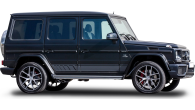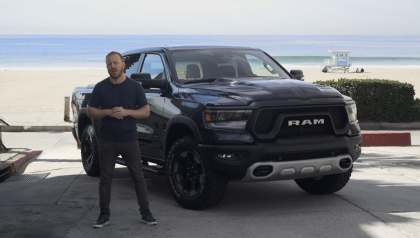Ute lovers in Australia are becoming so enamoured of super-sized US-style pick-ups – think Ram 1500, Chevrolet Silverado and the like – that the market for these jumbo utilities has rapidly become a hotly contested slice of the ute realm, growing swiftly in volume and variety.
And there’s more to come. The Nissan Titan is on its way here, as is, surely, the Toyota Tundra, Chevrolet Silverado 1500, the next-generation Ford F-150, and others but until then if you’re keen to scratch your big truck itch, you might consider a stretched version of an existing vehicle, say, for instance, the VW Amarok.
Adaptive Manufacturing, based in Adelaide, is responsible for VW-approved Amarok stretch jobs: designated the XL (which adds 310mm to the standard Amarok’s 3095mm wheelbase), and the XXL (which adds 650mm to that wheelbase).
But the chassis extension is much more than cosmetic because a Pedders GVM (gross vehicle mass) upgrade to go with the extra-length modification provides a GVM increase from 3080kg (as standard) to 3305kg (for the XL and XXL).
The stretch and GVM upgrade do not affect the standard vehicle’s five-year warranty.
We tested a VW Amarok 580 Ultimate cab chassis in XXL form over seven days, including a GVM load test.
Read on.
Volkswagen Amarok 2021: TDI580 Ultimate 4Motion
| Engine Type | Diesel Turbo V6, 3.0L |
|---|---|
| Fuel Type | Diesel |
| Fuel Efficiency | 8.9L/100km (combined) |
| Seating | 5 |
| Price From | $67,980 - $78,100 |
Does it represent good value for the price? What features does it come with?
An Amarok 580 Ultimate dual-cab chassis, as standard, has a manufacturer suggested retail price of $80,069.
.jpg)
This Amarok in XXL form has a price as tested of $110,782, but it has a few options including: the XXL dual-cab chassis conversion (Adaptive Manufacturing, under licence from Veth Automotive), $13,595; custom tray (Jacksons Australia Pty Ltd), $11,990; GVM increase (Pedders suspension and brakes), $4358; and the metallic paint (silver) is $770.
The features list on a standard dual-cab 580 Ultimate includes a 3.0-litre V6 turbo-diesel engine, eight-speed automatic transmission, Bi-xenon headlamps with LED separate daytime running light, leather-covered multi-function steering wheel with paddle shifters, Nappa leather-appointed upholstery, ergoComfort seats for driver and front passenger (14-way electrically adjustable, two-way manual), dual-zone air conditioning, stainless-steel pedals, tailored carpet mats, silver 20-inch Talca alloy wheels, and more.
Is there anything interesting about its design?
The Amarok has always been pretty easy on the eye in standard form and, in stretched XXL guise, it is very eye-catching indeed.
The substantial presence of its elongated physical dimensions, and the addition of chequer-plate tray and under-tray storage boxes, all combine to make this large-and-in-charge ute the target of numerous admiring stares.
.jpg)
What are the key stats for the engine and transmission?
The 580 Ultimate has a 3.0-litre turbo-diesel engine, producing 190kW at 4500rpm and 580Nm at 1400–3000rpm. An overboost function kicks that kilowatt figure up to 200kW, and comes in handy when overtaking.
It has an eight-speed automatic transmission and a permanent 4x4 system.
.jpg)
How practical is the space inside?
This Amarok’s interior feels nice but a little underdone, even though it does have a leather-wrapped steering wheel and Nappa leather-appointed upholstery.
.jpg)
There are hard plastics elsewhere, befitting what is ostensibly a work truck, and the cabin just doesn’t feel as classy as it used to, especially in light of its rivals in the highly competitive ute market.
The 6.33-inch colour multimedia touch-screen is too small.
Storage spaces are adequate rather than abundant and include the usual spots, such as glovebox, cupholders between driver and front passenger, and hard-plastic door pockets, but there are also handy work-truck additions, like the shallow dash-top tray (with a 12V socket).
There are no grab handles for the driver – A-pillar-mounted or otherwise.
In the Amarok’s favour though is the fact the front seats are very comfortable; the second-second-row seats, less so, but that’s to be expected.
.jpg)
There is shallow under-seat storage in the second row.
What's it like as a daily driver?
The extra 650mm length in the Amarok’s wheelbase that comes as a result of the Adaptive Manufacturing XXL extension, brings it to a 3745mm total and gives the Amarok a real added sensation of being planted on the road.
Even unladen, it exhibits impressive ride and handling and, with in-cabin NVH (noise, vibration and harshness) levels subdued to a hush, the Amarok could never be accused of ordinary refinement.
This is one ute that has always been nice to drive and to ride in, so much so that when it first arrived here in 2011 it undoubtedly set the gold standard for utes in Australia.
Well, it still is great, but much of the ute mob has caught up in terms of comfort and refinement, in fact some of them – not the least of which is the Ford Ranger – are close to surpassing it.
The V6 and eight-speed auto work well together, with low-stress, low-revs driving always the order of the day.
.jpg)
But with the XXL extension, adding that 650mm to the Amarok’s overall length, this ute tickles the 6m-long mark, at 5904mm, and has a 15.2m turning circle. That makes it a tad difficult to steer around congested city or suburban streets – not to mention making it a bit of a tricky truck to park. Not deal-breakingly difficult though.
The XXL chassis extension adds a claimed 85kg to this Amarok’s standard kerb weight of 2244kg, however, in the grand scheme of things, that additional weight is negligible and has no effect on this ute’s driveability.
Overall, this Amarok is a smooth-driving and very comfortable ute, and the chassis extension benefits the driving experience, rather than negatively impacting it.
What's it like for tradie use?
An XL or XXL wheelbase extension by itself does not alter the Amarok’s GVM – that’s where the Adaptive Manufacturing-approved Pedders GVM upgrade comes in. It adds 225kg to the standard ute’s GVM, bringing it to 3305kg.
The GVM upgrade includes the whole kit and caboodle: new coil springs and leaf springs, shock absorbers, as well as ceramic brake pads and more.
Payload is a claimed 1024kg after the GVM upgrade, up from the listed 836kg payload of the unmodified Ultimate.
For a real-world load test, I threw on about 300kg of miscellaneous gear – a camping fridge, two swags, three bicycles, two bags of vehicle-recovery gear, a tool bag, camera gear, two mini-mal surfboards and a few other bits and pieces. So, with four adults in the cabin, total additional weight onboard would have been tickling about 650kg, so well shy of that claimed 1024kg payload limit, but still a decent on-road load test, nonetheless.
With that load evenly positioned over the tray, the rear leaf springs compressed 15mm and the front end lifted about 2mm.
The aftermarket tray, by Adelaide-based Jacksons Australia, has a chequer-plate load surface, and is 2400mm long, 1950mm wide and has one robust tie-down point, centred at the front of the tray. Otherwise you can use the under-tray rails as anchor points for your load-securing system.
.jpg)
The tray also has several under-tray storage boxes and a long, shallow slide-out drawer that extends from the rear of the tray.
Load length in the tray increases from 1555mm to 2205mm with the XXL conversion.
Our drive loop included speed bumps, irregular bitumen surfaces, and a chance to drive at speeds of 110km/h or so on the highway.
The Ultimate’s 580Nm gives the Amarok plenty of pulling power from a standing start and ample punchiness on the go. The Amarok’s short first gear doesn’t hurt either for pulling away when fully loaded, and that’s just another appealing aspect of a smooth-shifting auto that’s always been pretty much on point.
.jpg)
Despite the XXL’s extra length and the added weight onboard, steering remained light and precise with a nice weight about it at all speeds.
The Amarok itself remained composed through a series of tight turns and speed bumps, and even wind gusts over long uphills and downhills failed to unsettle the Amarok.
It rides pretty well on 20-inch alloys, shod with Pirelli Scorpion All Terrain Plus (275/55 R20) tyres, and those are adequate for the job, but remember to adjust tyre pressures to suit the load onboard.
After that, I wanted to see how the XXL would handle a maximum load, so the friendly staff at IWP Training – “Illawarra’s Leading (HRW) High Risk Work Training Provider” – forklifted a water container (marked as “1000kg”) attached to a pallet – onto the tray of the Amarok.
.jpg)
Because we were exceeding the XXL’s listed 1024kg payload (taking into account the driver – me), I settled for a static load-test, just to see how it would handle a one-tonne burden.
With the load positioned on the tray, the rear leaf springs compressed 40mm and the front end lifted 9mm.
Note: the ute’s ramp-over angle is reduced from 23 degrees to 19 degrees so be careful as you traverse any lumpy terrain.
Maximum towing capacity is 750kg (unbraked), and 3500kg (braked).
The XXL extension does not change this V6 Amarok’s GCM (gross combined mass) of 6000kg.
How much fuel does it consume?
This Amarok’s fuel consumption is listed as 8.9L/100km.
On test, we recorded an actual fuel consumption of 12.7/100km after more than 250km of driving including the load test.
Warranty & Safety Rating
What safety equipment is fitted? What safety rating?
The Amarok has a maximum five-star ANCAP safety rating.
Safety gear as standard on the VW Amarok 580 Ultimate includes airbags for driver and front-seat passenger, trailer stabilisation, rear view camera, hill start assist, hill descent assist, cruise control, tyre pressure monitoring system, and a mechanical rear differential lock.
Electronic stability control (ESC) has been tuned to suit the longer wheelbase.
.jpg)
Verdict
The VW Amarok 580 Ultimate is a smooth-driving, refined ute as standard and is further improved in XXL guise.
It’s even nicer to drive in stretched form and handles the burden of a maxed-out load with ease, so it makes sense as a comfortable, load-hauling work truck.
The Amarok XXL costs north of $100 grand, so it’s not within the reach of many mainstream ute buyers, but that is around the price-point where super-sized utes like this reside, and lovers of big US-style trucks – the Ram 1500, Chevrolet Silverado etc – don’t baulk at spending big bucks any way.
The realm of super-sized utes is only going to get busier, but until then, if you’re into these big rigs, the Amarok XXL makes a strong case for your consideration.
Pricing Guides







.jpg)

.jpg)
.jpg)




.jpg)





.jpg)